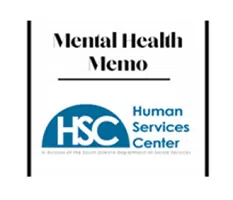JULY 2024:
About the Author: Christine Graves, BSN, RN, works as a Charge Nurse at the Human Services Center (HSC) and serves the patients of the Gateway Treatment Program. She earned Bachelor of Science degrees in Nursing and Psychology from the University of South Dakota. Chris enjoys spending time with her family and friends, walking, and spending time outdoors.

Courtesy photo.
Chances are you probably know someone who has been affected by addiction. With over 48 million people being diagnosed with a substance use disorder in 2022 (U.S. Substance Abuse and Mental Health Services Administration, 2022 National Survey Drug Use and Health Annual Report), anyone can suffer from addiction at any time during their life. This may be a family member, co-worker, friend, or neighbor. The term recovery refers to the process where an individual has abstained from the use of drugs or alcohol to improve their overall health and wellness. Below are some tips for you to help an individual achieve a better life and for you to understand more fully how the supports offered to a loved one in recovery can positively impact their journey.
Educate Yourself: Addiction is a chronic disease where you do not have control over doing, taking, or using something to the point where it could be harmful. Addiction is typically classified as using drugs or alcohol; however, shopping, food, screen time, and gambling addictions are common, as well. Being able to recognize that addiction is a life-long disease that may require different treatment methods such as counseling and medications. Encouragement/support is also beneficial as you support an individual you love in recovery.
Be Patient: It is a rare person who can change their behavior overnight. In early recovery, they may still make poor decisions. Healing and growth will take time and discipline. If setbacks and relapses with drugs and alcohol occur, continue to show love, concern, and support. Remember that they are building a new life that is unfamiliar to them.
Listen: People who are in recovery have a lot of appointments and meetings to attend. Despite being around others who are in recovery, they may feel lonely and overwhelmed at times. Being present and engaged in conversation with them as they share information with you is an important part of being supportive. Paraphrasing what they are telling you also shows them that you are actively listening.
Know the Signs of Relapse: The definition of relapse is the use of drugs or alcohol after a period of not using drugs or alcohol. Relapse happens frequently, with up to 40% to 60% of individuals relapsing within 30 days of leaving an inpatient treatment program, and up to 85% of individuals relapsing within the first year of recovery (National Institutes of Health). Relapsing can be an important experience for individuals, as it typically solidifies their commitment to recovery. Although everyone is different, knowing the signs of relapse can help prompt them to seek professional help to get them back on track. Some warning signs include associating with persons with whom or places at which prior use took place, suspicious changes in mood and behavior, or glamorizing the past and prior substance use.
Encourage New and Healthy Activities: One of the hardest things for those in early recovery is finding activities that do not involve drugs or alcohol. Whether it be eating healthy, getting enough sleep, physical exercise, or practicing open and honest communication, you can show support by practicing these healthy habits yourself. Not only do these activities improve your overall health and wellness, but it can also be a source of bonding and healing between you and the person in recovery.
Find Your Own Support: Supporting a loved one in recovery can take a toll on your own mental and physical health. Practicing self-care is not only an important part for everyday life, but it also demonstrates recovery related behaviors to the person in recovery. Support groups, such as Al-Anon and Alateen, are specific to those whose lives have been affected by someone else’s drinking. SMART Recovery is another evidence-informed support group for those who have been touched by addiction.
In conclusion, addiction is a common condition that can affect anyone. There are several different ways that you can support an individual who is in recovery. If you or someone you love is suffering from addiction, call, text, or chat 988 to connect with local professionals at the Helpline Center.
For more information, visit www.sdbehavioralhealth.gov.
JUNE 2024:
About the author: Haley Conrad is a Therapeutic Recreation Specialist (TRS) at the Human Services Center (HSC). Over the 6 years employed at HSC, she has worked alongside multiple treatment programs at the hospital. Her favorite age group to work with is adolescents. Haley is currently a graduate student of the Doctor of Occupational Therapy program at the University of South Dakota. She looks forward to continuing to provide activities-based treatment interventions as she furthers her education and career.

Courtesy photo.
We’ve all been told that exercise is good for us. People are motivated to exercise for many different reasons such as losing weight, boosting endurance, and improving cardiovascular fitness. One benefit of exercise that is often overlooked, however, is the positive effect on your mental health. Physical activity reduces anxiety, stress, depression, and negative mood. Physical activity improves your mood, energy-levels, cognitive function, and social interaction. It is recommended to get at least 30 minutes of moderate-intensity exercise three days a week to achieve these health benefits. These 30 minutes don’t have to be all at once. For example, you could break up the 30 minutes into three 10-minute activities. This can be accomplished quite easily if you have a gym membership, however, many of us would prefer to find physical activity outlets that work better with our lifestyles, abilities, and routines. We can accomplish this by considering the day-to-day activities that are meaningful, important, and enjoyable to us. You are more likely to have success consistently staying active if the exercise relates to these kinds of activities. You may not even realize you’re exercising!
Here are a few examples of ways to fit in physical activity without stepping a foot into the gym that you might enjoy adding to your weekly routine:
Gardening/Landscaping- Commit to a summer garden or update the look of your yard. These are both great ways to get active outdoors.
Playing with Kids- Get yourself and your kids off the technology for a while and fit in some purposeful playtime!
Active Video Games- Games that involve standing up and moving around are a great way to incorporate some extra exercise while having fun indoors.
Local Parks- Check out your local hiking spots, playgrounds, sport courts/fields, walking paths, etc.
Walking the Dog- If you can’t motivate yourself to exercise for your own health, do it for your dog’s!
Building- Building stuff involves lots of bending, picking things up, and maneuvering.
Swimming- Whether it’s at a pool or the beach, swimming is an excellent way to get exercise.
Cleaning/Organizing- Have some chores or projects to get done? Cleaning and organizing around the house are productive ways to sneak in some physical activity.
Biking- Perhaps you might consider biking to and from work if you live within a reasonable distance.
Walking & Talking- Do you commonly chat on the phone? Take that phone on a walk and you’ll get tons of steps in while being distracted on the call. Even better, you can bring along a friend or family member to walk and talk with you.
There are MANY other ways to fit physical activity into your weekly routine and reap the benefits for not only your body, but also your mind. Try to come up with some other ideas that would work best for you.
Check out https://healthysd.gov/category/physical-activity/ for additional ideas and resources.
MAY 2024:
About the author: This month’s Mental Health Memo is a joint effort from the staff at the Human Services Center and the Department of Social Services Division of Behavioral Health.
You’ve probably heard of Simon Sinek—he’s that guy known for inspiring talks and books about leadership and finding purpose in what we do. But one of his lesser-known gems is the question he poses: “Do You Have 8 Minutes?” It might seem like a simple question, but its implications for mental health are profound.
So, what’s the deal with these 8 minutes? Sinek suggests that dedicating just 8 minutes a day to activities like mindfulness, meditation, or reflection can significantly improve our mental well-being. In today’s fast-paced world, where stress and anxiety are all too common, taking even a brief amount of time to prioritize our mental health can make a world of difference.
But how exactly does this relate to mental health? Well, think of it like this: Our brains are constantly bombarded with information and stimuli, from social media notifications to school and work demands. This non-stop barrage can leave us feeling overwhelmed and drained. By setting aside 8 minutes each day for practices like deep breathing or meditation, we give our minds a chance to reset and recharge. It’s like hitting the reset button on a computer—it helps us clear away the mental clutter and approach life with renewed clarity and focus.
Moreover, engaging in these mindfulness practices has been shown to reduce stress, anxiety, and even symptoms of depression. When we take the time to quiet our minds and connect with the present moment, we become better equipped to handle life’s challenges with grace and resilience.
But perhaps the most significant aspect of Sinek’s message is the idea of intentional living. By consciously carving out time for self-care and reflection, we reclaim control over our lives and align our actions with our values and goals. This sense of purpose and alignment not only enhances our mental well-being but also empowers us to lead more fulfilling and meaningful lives.
Sinek’s “Do You Have 8 Minutes?” serves as a reminder that mental health is not something to be overlooked or pushed to the side—it’s an essential part of our overall well-being. By dedicating just a fraction of our day to nurturing our minds, we can cultivate greater resilience, happiness, and fulfillment. So the next time you find yourself caught up in the chaos of life, ask yourself: “Do I have 8 minutes?” Your mental health will thank you for it.
For professional help, please call, text or chat 988 at https://988lifeline.org/chat/.
To access free mindfulness videos visit: https://www.youtube.com/@SDBehavioralHealth.
APRIL 2024:
About the author: Bella Glissendorf is the Substance Use Prevention Program Specialist with the Department of Social Services, Division of Behavioral Health. Prior to this role, she worked at the Southeastern Prevention Resource Center working in prevention at the community level. Bella has a Bachelor of Arts degree in Applied Psychology & Human Development from Boston College.

Courtesy photo.
Spring cleaning this year? Don’t forget to include your medicine cabinet! Many of us accumulate multiple medications over the course of a year, whether it’s over the counter medication for a pesky cold or stronger medication prescribed to us by our doctor for a more serious medical condition. April 19, 2024 is National Clean out your Medicine Cabinet Day which occurs annually on the third Friday in April. This day is a great reminder to take a little bit of time to clean out your medicine cabinet of any expired, unused, or no longer needed medication.
Storing unneeded and unused medications in an easily accessible cabinet at home can put your loved ones, including children, adults, and pets, at risk for misusing medication or having an accidental overdose. 65.9% of opioids are obtained by people through a friend or relative (either for free, for a charge, or from theft), so it’s important we take stock of our inventory and dispose of the medication we no longer need.
Keeping expired medication around in the case of needing it again is not advised. According to the U.S. Food and Drug Administration, expired medications become ineffective and dangerous due to a change in chemical composition that typically takes place over time and/or when the conditions in which the medications are stored changes.
Lastly, it’s important to refrain from keeping leftover prescription medication such as pain medication or antibiotics to give to others when they are ill or to self-medicate. Medications prescribed by a doctor are intended to be used with the instructions listed on the bottle, and they can only be deemed safe when used correctly by the person they were prescribed to.
What are the types of medication that should be removed from your medicine cabinet?
• Any expired medication (including vitamins, supplements, creams, over the counter medicine and prescription medication);
• Any medication that is unmarked, not in the original container, and that you are unsure of its expiration date and what type of medication it is;
• Any medication that has changed in color, smell or taste or if it has been exposed to too much light as the medicine may be altered and therefore risky to ingest; and
• Prescription medication that you are no longer taking (pain medication for an acute condition, antibiotics, etc.).
What should you do with the medication you have removed from your cabinet?
1. Drop it off at a drug take-back location as take-back sites will properly and safely dispose of the medication for you. Many pharmacies and police stations accept medication year-round, and there are several take-back sites in SD that can be found using this link https://www.avoidopioidsd.com/
2. Dispose of your medication by using a Dispose RX packet. Once mixed into the medication bottle, the Dispose RX packet chemically and physically neutralizes the medication thereby making it ineffective as well as safe for the environment when thrown away. Dispose RX packets can be used with pills, capsules, tablets, liquids, and powders. Dispose RX packets can be ordered for free through this link https://helplinecenter.
3. If you do not have access to a take-back site or a dispose RX packet, check to see if your medication falls within the FDA’s Flush List found using this link https://www.fda.gov/drugs/
4. If you do not have access to a take-back site, do not have a Dispose RX packet, and your medication is not on the FDA Flush List, dispose your medicine in the trash utilizing these steps.
1. Remove the drugs from the original container;
2. Mix your medication with things such as used coffee grounds, cat litter, or dirt to make it unappealing to children and pets and unrecognizable to someone intentionally going through the trash looking for drugs;
3. Place the mixture in something you can close (a zippered plastic bag or container with a lid) to prevent the mixture from leaking; and
4. Throw the container in the trash.
It is extremely important to dispose of medication properly so that we can keep our loved ones and our environment safe. This National Clean Out Your Medicine Cabinet Day, make it a priority to get rid of unused, unneeded, and expired medication from your home.
FEBRUARY 2024:
Healthy Communication: I can’t read your mind!
About the author: Courtney Vander Pol, MSW, LCSW, QMHP is a Psychiatric Social Worker at the Human Services Center. She works in the Psychiatric Rehabilitation Program and with the Competency Restoration Program. Courtney graduated from the University of South Dakota with her Bachelor’s and Master’s in Social Work. She enjoys traveling, drawing, painting, and snuggling with her cats.

Courtesy photo.
We’re all doing it – all day, every day, whether we want to or not, everyone is constantly communicating with each other. It helps each of us meet our needs as individuals. Although communication is a common yet important skill, healthy communication requires additional effort, time, and motivation. Here are tips to polish your communication skills for your daily and more challenging conversations.
- Pay attention to your current emotions and mood. Are you happy, sad, angry, confused? Identifying your own emotions will assist your explanation of your feelings. If this similar feeling returns in the future, there is an increased chance you will know how to respond and approach the challenge.
- Be aware of both your verbal and nonverbal communication. Your facial expressions and body language are as important as the words coming out of your mouth.
- Hold a confident posture whether you are standing or sitting. Poor posture shows what you are trying to say does not mean much to you.
- Keep a calm tone of voice. No one wants to be yelled at. Your calm tone will encourage the person you are talking with to remain calm.
- Think before you speak. Once you say something, it has been said. There is no going back to remove what was said.
- Using “I feel” statements will communicate your needs. Simple statements such as “I feel upset” will tell the person you’re talking to how you currently feel. If this person is supportive in your life, they will take your information and start problem-solving with you. Supportive people in your life care about you and do not want to see you suffer emotionally or mentally.
- Actively listen to the person you are communicating with. This includes making appropriate eye contact (research cultural practices on the importance of eye contact/no eye contact), not interrupting the person speaking, and allowing them to clearly state their point before asking questions.
- Stay away from blaming others. “You always do this. You make me so angry.” These statements are usually taken as an emotional attack and will make the person you are talking to become defensive and shut down in the conversation. Once someone has shut down and refuses to communicate, a solution is less likely to be found.
- Clearly express your need to move forward from the conversation. For example, “I need help with chores to keep the house clean” clearly states what this person wants out of the conversation. Unfortunately, people cannot read other’s minds. If the need is not clearly stated, the other person may not know how to respond.
- Be open to compromise. If you are trying to work through challenges with others, there will be times when you need to compromise to settle disagreements. Stay open-minded about what needs you are working to fulfill. Identifying how you may benefit healthily will strengthen your compromise.
- It is important to note that verbal and electronic communication have similarities and differences. When communicating via text or email, there is a risk of misunderstanding the information and the individual receiving the message may interpret the tone differently than what was intended. If there are concerns that the information may be misunderstood or miscommunicated, or if communicating about a sensitive topic, it may be best to relay the information verbally or to follow up with the individual you are communicating with verbally to ensure they understand your message. This will also provide an opportunity for the receiving person to ask any clarifying questions.
- Learn to accept the things you cannot change. Change is hard, but it will continue to happen. There are simply parts of life no one can change as much as they would like to. Good changes will come.
Although we as humans are in constant communication with one another, let us be mindful that there is always room to improve how we communicate with one another. It is important to note that practice makes perfect. Some of the hardest discussions people have are deeply connected to their emotions making it difficult to communicate. Find supportive people in your life that you can trust. Turn to a mental health professional if you need assistance because life presents tough challenges. Practice these healthy communication skills to feel heard and solve challenges.
JANUARY 2024:
A DBT-Informed New Year: Building Mastery to Achieve Your Goals in 2024
About the author: Katie Anderson, CSW-PIP is a Psychiatric Social Worker at the Human Services Center (HSC). Anderson provides clinical therapy services and Dialectical Behavior Therapy (DBT) Skills in HSC’s Adolescent Program. In her spare time, she enjoys running and gardening.

Courtesy photo.
The New Year is a new beginning filled with opportunity, inspiration, and optimism. Folks often set ambitious resolutions with good intentions of getting a fresh start in the New Year. After all, it can be exciting to use that motivation to amp ourselves up for a big challenge! While there is certainly nothing wrong with having enthusiasm for personal growth, the momentum unfortunately tends to fade as the year progresses. In fact, a variety of studies have estimated that nearly 80% of New Years resolutions are given up by February. Maybe you’re already experiencing this by the time you’re reading this article in mid-January. Or maybe you’ve avoided setting a resolution this year for that reason!
Why do so many of us forego our New Years resolutions? When we adopt the ‘Go Big or Go Home’ mindset on January 1, it does not leave much room to give ourselves grace. Ambitious goals can become a daunting source of stress when we settle back into our day-to-day routines. And when we slip up on those big resolutions, that type of polarized mindset may tempt us to throw in the towel and leave us feeling disappointed in ourselves again. Unfortunately, goals that are rooted in shame and guilt rarely result in lasting changes.
So, are all resolutions just futile efforts? No, this is luckily not the case. New Years resolutions can still be achievable with the right approach. One way to do this is by using the ‘Build Mastery’ skill. The concept of Building Mastery originates from Dialectical Behavior Therapy (DBT), a mental health treatment approach developed by Dr. Marsha Linehan. DBT provides a variety of skills to help individuals regulate their emotions and create “a life worth living”.
Building Mastery means scheduling doable tasks that make you feel effective and capable of getting things done. Over time, a series of accomplishments leads to increased self-efficacy. Not only is this strategy helpful for achieving goals, but it is also an important component of treating depression. Dr. Linehan indicates that the Build Mastery skill can be a “line of defense against helplessness and hopelessness”. Feeling competent prepares you for difficult challenges, which can be especially helpful when feeling disheartened by New Years resolutions. Below are three guidelines for Building Mastery adapted from Dr. Linehan’s DBT Manual:
1) Do at least one thing per day.
Lasting benefits are the result of many small, incremental changes. Ask yourself, what slight change would make the smallest noticeable difference? These actions are sometimes referred to as ‘micro-steps’. Want to become an avid reader in 2024? Start with 15 minutes of reading per day, every day. It may seem like micro-steps aren’t significant enough to make a difference; However, small successes are the catalyst for big changes. For example, just 15 minutes of daily reading is tipping point for increased reading achievement and growth in students, according to the world’s largest annual study of K-12 students (Renaissance Learning, 2023). Think of this approach as a domino effect for personal growth.
2) Choose something that is challenging, but possible.
As Dr. Linehan notably states, “Lives of failure are lives where expectations are too high”. It is important to balance challenge and achievability by choosing goals that will be attainable given your circumstances. If your goal is to become a marathon runner, it may be tempting to jumpstart your training with high-mileage workouts; however, if your current weekly schedule does not involve exercise, starting with a 5-mile run may be an unrealistic starting point. Make sure to acknowledge your current fitness level without self-judgement when setting a new fitness goal. Self-improvement can co-exist alongside self-acceptance.
3) Gradually increase difficulty.
Once you’ve consistently accomplished 15 minutes of daily reading, increase it to 20 minutes per day. Once you’ve mastered running one mile with ease, practice running two miles. Building confidence in our capabilities helps us be more resilient to discomfort. I’ve personally experienced this by implementing a 10-minute nightly cleaning routine. Although 10 minutes may seem insignificant, now 20 or 30 minutes of cleaning doesn’t seem so daunting when I’m already accustomed to setting a timer for at least 10 minutes of cleaning every night. There are endless opportunities for growth when you build mastery with micro-steps of progress.
By challenging ourselves in these small ways every day, we can move closer towards achieving our goals in the New Year. And most importantly, self-improvement is always best achieved when balanced with self-acceptance. I wish you good mental health, much personal growth, and great success in 2024!
References:
Linehan, M. (2015). DBT skills training handouts and worksheets (2nd ed.). The Guilford Press. Renaissance Learning. (2023). What kids are reading: 2023 edition. https://www.renaissance.com/wkar
To read previous editions of the Mental Health Memo visit https://dss.sd.gov/keyresources/news.aspx#mhmemo.

